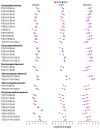Anthracyclins Increase PUFAs: Potential Implications in ER Stress and Cell Death
- PMID: 34064765
- PMCID: PMC8151859
- DOI: 10.3390/cells10051163
Anthracyclins Increase PUFAs: Potential Implications in ER Stress and Cell Death
Abstract
Metabolic and personalized interventions in cancer treatment require a better understanding of the relationship between the induction of cell death and metabolism. Consequently, we treated three primary liver cancer cell lines with two anthracyclins (doxorubicin and idarubin) and studied the changes in the lipidome. We found that both anthracyclins in the three cell lines increased the levels of polyunsaturated fatty acids (PUFAs) and alkylacylglycerophosphoethanolamines (etherPEs) with PUFAs. As PUFAs and alkylacylglycerophospholipids with PUFAs are fundamental in lipid peroxidation during ferroptotic cell death, our results suggest supplementation with PUFAs and/or etherPEs with PUFAs as a potential general adjuvant of anthracyclins. In contrast, neither the markers of de novo lipogenesis nor cholesterol lipids presented the same trend in all cell lines and treatments. In agreement with previous research, this suggests that modulation of the metabolism of cholesterol could be considered a specific adjuvant of anthracyclins depending on the type of tumor and the individual. Finally, in agreement with previous research, we found a relationship across the different cell types between: (i) the change in endoplasmic reticulum (ER) stress, and (ii) the imbalance between PUFAs and cholesterol and saturated lipids. In the light of previous research, this imbalance partially explains the sensitivity to anthracyclins of the different cells. In conclusion, our results suggest that the modulation of different lipid metabolic pathways may be considered for generalized and personalized metabochemotherapies.
Keywords: ferroptosis; hepatocellular carcinoma; lipidomics; plasmalogen; plasmanyl; plasmenyl.
Conflict of interest statement
The authors declare no conflict of interest.
Figures












Similar articles
-
Lipidomic biomarkers and mechanisms of lipotoxicity in non-alcoholic fatty liver disease.Free Radic Biol Med. 2019 Nov 20;144:293-309. doi: 10.1016/j.freeradbiomed.2019.05.029. Epub 2019 May 29. Free Radic Biol Med. 2019. PMID: 31152791 Review.
-
TRAP1 role in endoplasmic reticulum stress protection favors resistance to anthracyclins in breast carcinoma cells.Int J Oncol. 2014 Feb;44(2):573-82. doi: 10.3892/ijo.2013.2199. Epub 2013 Nov 29. Int J Oncol. 2014. PMID: 24297638
-
Perilipin-2 Deletion Impairs Hepatic Lipid Accumulation by Interfering with Sterol Regulatory Element-binding Protein (SREBP) Activation and Altering the Hepatic Lipidome.J Biol Chem. 2016 Nov 11;291(46):24231-24246. doi: 10.1074/jbc.M116.759795. Epub 2016 Sep 27. J Biol Chem. 2016. PMID: 27679530 Free PMC article.
-
n-3 Polyunsaturated fatty acids for the management of alcoholic liver disease: A critical review.Crit Rev Food Sci Nutr. 2019;59(sup1):S116-S129. doi: 10.1080/10408398.2018.1544542. Epub 2018 Dec 22. Crit Rev Food Sci Nutr. 2019. PMID: 30580553 Review.
-
Lipid availability influences ferroptosis sensitivity in cancer cells by regulating polyunsaturated fatty acid trafficking.Cell Chem Biol. 2025 Mar 20;32(3):408-422.e6. doi: 10.1016/j.chembiol.2024.09.008. Epub 2024 Oct 22. Cell Chem Biol. 2025. PMID: 39442523
Cited by
-
Limitations and Possibilities of Transarterial Chemotherapeutic Treatment of Hepatocellular Carcinoma.Int J Mol Sci. 2021 Dec 2;22(23):13051. doi: 10.3390/ijms222313051. Int J Mol Sci. 2021. PMID: 34884853 Free PMC article. Review.
-
Drug Resistance and Endoplasmic Reticulum Stress in Hepatocellular Carcinoma.Cells. 2022 Feb 11;11(4):632. doi: 10.3390/cells11040632. Cells. 2022. PMID: 35203283 Free PMC article. Review.
-
Variational autoencoders learn transferrable representations of metabolomics data.Commun Biol. 2022 Jun 30;5(1):645. doi: 10.1038/s42003-022-03579-3. Commun Biol. 2022. PMID: 35773471 Free PMC article.
-
Orthogonality in Principal Component Analysis Allows the Discovery of Lipids in the Jejunum That Are Independent of Ad Libitum Feeding.Metabolites. 2022 Sep 14;12(9):866. doi: 10.3390/metabo12090866. Metabolites. 2022. PMID: 36144270 Free PMC article.
-
In Vitro Cell Toxicity and Intracellular Uptake of Doxorubicin Exposed as a Solution or Liposomes: Implications for Treatment of Hepatocellular Carcinoma.Cells. 2021 Jul 6;10(7):1717. doi: 10.3390/cells10071717. Cells. 2021. PMID: 34359887 Free PMC article.
References
-
- Smith M.R., Chacko B.K., Johnson M.S., Benavides G.A., Uppal K., Go Y.-M., Jones D.P., Darley-Usmar V.M. A Precision Medicine Approach to Defining the Impact of Doxorubicin on the Bioenergetic-Metabolite Interactome in Human Platelets. Redox Biol. 2020;28:101311. doi: 10.1016/j.redox.2019.101311. - DOI - PMC - PubMed
Publication types
MeSH terms
Substances
Grants and funding
LinkOut - more resources
Full Text Sources
Medical
Research Materials

